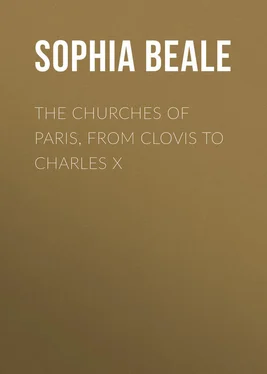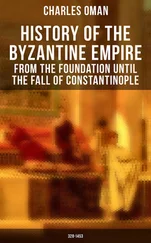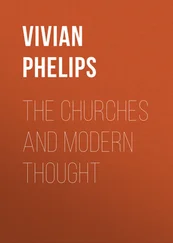Sophia Beale - The Churches of Paris, from Clovis to Charles X
Здесь есть возможность читать онлайн «Sophia Beale - The Churches of Paris, from Clovis to Charles X» — ознакомительный отрывок электронной книги совершенно бесплатно, а после прочтения отрывка купить полную версию. В некоторых случаях можно слушать аудио, скачать через торрент в формате fb2 и присутствует краткое содержание. Жанр: foreign_antique, foreign_prose, на английском языке. Описание произведения, (предисловие) а так же отзывы посетителей доступны на портале библиотеки ЛибКат.
- Название:The Churches of Paris, from Clovis to Charles X
- Автор:
- Жанр:
- Год:неизвестен
- ISBN:нет данных
- Рейтинг книги:3 / 5. Голосов: 1
-
Избранное:Добавить в избранное
- Отзывы:
-
Ваша оценка:
- 60
- 1
- 2
- 3
- 4
- 5
The Churches of Paris, from Clovis to Charles X: краткое содержание, описание и аннотация
Предлагаем к чтению аннотацию, описание, краткое содержание или предисловие (зависит от того, что написал сам автор книги «The Churches of Paris, from Clovis to Charles X»). Если вы не нашли необходимую информацию о книге — напишите в комментариях, мы постараемся отыскать её.
The Churches of Paris, from Clovis to Charles X — читать онлайн ознакомительный отрывок
Ниже представлен текст книги, разбитый по страницам. Система сохранения места последней прочитанной страницы, позволяет с удобством читать онлайн бесплатно книгу «The Churches of Paris, from Clovis to Charles X», без необходимости каждый раз заново искать на чём Вы остановились. Поставьте закладку, и сможете в любой момент перейти на страницу, на которой закончили чтение.
Интервал:
Закладка:
Paris formerly, even as late as the last century, contained many spots sacred to the memory of S. Denis and his three companions. At Notre-Dame-des-Champs a crypt used to be shown where they preached to their first disciples. At S. Benoît, now destroyed, there was formerly an oratory, on the wall of which was an inscription recording that S. Denis first invoked the name of the Most High on that spot. At S. Denis-de-la-Chartre was the prison where the martyrs were visited by our Lord, and where He administered His Blessed Body and Blood to them. At S. Denis-du-Pas was the ground upon which they suffered their first tortures; and upon Montmartre the church of S. Pierre records the spot upon which they were decapitated. The way across the plain from Montmartre to the place of burial was marked by a succession of crosses, and the field where the Saint's remains were laid subsequently became the precincts of the famous abbey.
The first church is said to have been erected before the invasion of the Franks, but this had fallen into ruins in the 5th century, and it was through the piety of S. Geneviève and the people of Paris that it was rebuilt. This Saint, like all good Parisians, held S. Denis in great esteem; and it was during a visit paid to his shrine that her taper, maliciously blown out by the arch-enemy, was successfully relighted through the fervour of her prayers. Gregoire de Tours relates many wondrous miracles which took place in the new church for the benefit of the faithful and the chastisement of the wicked.
But the magnificence with which Dagobert rebuilt and endowed S. Denis completely eclipsed the work of the maid of Nanterre; and so effectually was the king looked upon as the founder of the abbey that, up to the dissolution of the monasteries, the monks celebrated his festival upon the 19th of January with great solemnity and splendour. It was about the year 630 that Dagobert undertook the rebuilding of the church, which is said to have been decorated with precious marbles, magnificent bronze doors, and gold and silver vessels enriched with precious stones. These latter, and the shrine of the Saint, as well as the great cross at the entrance of the choir, were the work of the famous artificer in metals, S. Eloy, who was also the maker of the shrines of SS. Martin, Germain, and Geneviève. These, and, in fact, all this great smith's works (as far as is known) have perished; but his memory is still preserved by pictures and sculptures representing some of the legendary incidents of his life. In the Firenze Academy is a picture by Botticelli, and at the church of Or San Michele is a statue and a bas-relief, both of which represent one of the great events of the Saint's life. A horse having been brought to him to be shod, the animal proved restive, and the Saint being exercised in his mind as to how he should keep the beast still, bethought him of an excellent plan. He calmly cut off the leg, and placing it upon his anvil, fastened on the shoe; this done, he replaced the leg upon the horse, to the amazement of the beast and the edification of his owner. Another picture, painted for the Company of the Goldsmiths, represents S. Eloy under the form of Benvenuto Cellini, presenting a shrine to King Dagobert, who figures in the costume of François I^er. In 754, Pépin and his queen Berthe, after being anointed at S. Denis by Pope Stephen II., began the reconstruction of the Merovingian church which Charlemagne finished and dedicated in 775. From that year until the 12th century, little is known of the history of the abbey. Like all churches and monasteries in the north of France, it was probably destroyed, and its lands laid waste by the invasions of the Northmen and the disastrous civil wars which characterised the end of the Carlovingian dynasty, for nothing remains of the magnificence of the churches of Dagobert and of Charlemagne but a few columns and marble capitals in the crypt.
The third and present church was commenced by the great Abbot Suger, and is considered by many French architects to be the earliest example of Pointed architecture. Suger erected the tower, the portals, the nave, and the choir in rapid succession, and subsequently the chevet and chapels; he filled the windows with the most exquisite jewel-like stained glass, and loaded the shrines and altars with precious stones. Some of the sacred vessels formerly belonging to the church are now in the Salle d'Apollon of the Louvre, and testify to the exquisite artistic taste as well as to the religious enthusiasm of the good abbot. " As it is our duty to present unto God oblations of gems and of gold, I, Suger, offer this vase unto the Lord ," is the inscription upon an antique sardonyx amphora which he converted into a vessel for the altar. The dedication of this church took place twice, in 1140 and 1144, but it was only to remain intact some 70 years. In 1219, the day after the feast of the nativity of the Virgin, its flèche was struck by lightning, and a few years after, the church itself was partially destroyed. Abbot Eudes Clément replaced the wooden flèche by a stone one, and raised the interior of the apse; and his third successor, Matthieu de Vendôme, finished the transept and the nave. The chapels of the nave upon the north side were built in the 14th century, and a few unimportant additions were made in the succeeding century. Of the magnificent circular chapel of the Valois erected for Henri II. and Catherine de'Medici, nothing remains but a beautiful colonnade, now forming a sham ruin in the Parc Monceau. The chapel was situated upon the north of the apse, near the steps, and was destroyed during the regency of Philippe d'Orléans, in 1719.
It is generally supposed that the destruction of churches and the despoiling of monasteries in France were the work of the enemies of religion in the form of the "people." But the kings did not hesitate to rob the church when they could drain no more money out of their long-suffering subjects. To Francis I. 12 12 See the Inventory of the Treasury of Laon, from which we cull the following: In 1523, when François I. wanted money to carry on his war against Charles V. and Henry VIII., we read in Journal d'un Bourgeois de Paris , his manner of getting it. "Le roy envoya aussi quérir trois ou quatre appostres d'or qui estoient ès-reliques en l'église épiscopale à Laon, en Picardie, dont il y en avoit douze, mais les aultres n'estoient que d'argent, parquoy furent délaissez; et valloient iceux III. ou IIII. appostres environ quatre mille escus; et fit ce le roy pour subvenir et ayder en ses guerres de Picardie qu'il avoit contres les Anglais." Louis XIV. also, when his star had paled a little, put various cathedral chapters under contribution; the church of Notre-Dame de Liesse sending silver to the royal treasury to the amount of 28,600 livres.
and Louis XIV. the eighth commandment was no more binding than the seventh; laws, divine or otherwise, were made for the vulgar herd, not for their most Christian Majesties; and so, when the "Grand Monarque" saw fit to please Mme. de Maintenon by founding St. Cyr, he suppressed the abbacy of S. Denis, and relieved the monastery of the abbot's revenues for an endowment. This was the beginning of the downfall, and in 1791, the Benedictines were dispersed after an occupation of twelve centuries. In the memoirs of the organist attached to the abbey at the time, there is a touching account of the last mass celebrated by the prior upon the day of departure. But the church remained intact, and was even made the dépôt of the relics of the Sainte-Chapelle, 13 13 See pages 18, 19.
after the suppression of the chaplains belonging to the latter. The Moniteur of 3rd September, 1791, gives an account of the sittings of the commission of savants , established at the Bibliothèque des Quatre-Nations, for the consideration of the preservation of works of art. This commission was appointed by the National Assembly after the passing of the law for the appropriation of the property of the clergy by la chose publique . M. De Larochefoucauld was the president of this "Commission des Monuments," assisted by many artists and connoisseurs . They first of all chose certain places as receptacles for the works of art, and then decided what to keep and what to destroy. The former quarters of the Petits-Augustins became the museum of tombs and sepulchral sculptures; and to the Capucins, the Grands-Jésuites, and the Cordeliers were sent the books and manuscripts. A descriptive catalogue was drawn up by Alexandre Lenoir, 14 14 Musée des Monuments Français.
who was appointed curator in 1790. Unfortunately, much was destroyed, as, for instance, at the abbey of Royaumont, where two Benedictines, Poirier and Puthod, were sent by the commission to superintend matters. The mausoleum of the princes of S. Louis' family was " démoli avec adresse ," says the Moniteur ; the coffins were opened " avec circonspection ," the ashes taken up with care, and then, ticketed and sealed, sent to S. Denis. Les sieurs Puthod and Poirier carried off the remains of seven princes and six monuments, which arrived just in time to be packed off to the museum of the Petits-Augustins.
Интервал:
Закладка:
Похожие книги на «The Churches of Paris, from Clovis to Charles X»
Представляем Вашему вниманию похожие книги на «The Churches of Paris, from Clovis to Charles X» списком для выбора. Мы отобрали схожую по названию и смыслу литературу в надежде предоставить читателям больше вариантов отыскать новые, интересные, ещё непрочитанные произведения.
Обсуждение, отзывы о книге «The Churches of Paris, from Clovis to Charles X» и просто собственные мнения читателей. Оставьте ваши комментарии, напишите, что Вы думаете о произведении, его смысле или главных героях. Укажите что конкретно понравилось, а что нет, и почему Вы так считаете.




![Theresa Cheung - The Dream Dictionary from A to Z [Revised edition] - The Ultimate A–Z to Interpret the Secrets of Your Dreams](/books/692092/theresa-cheung-the-dream-dictionary-from-a-to-z-r-thumb.webp)







